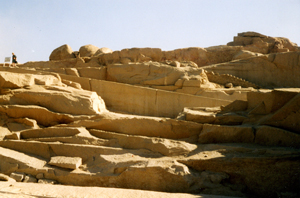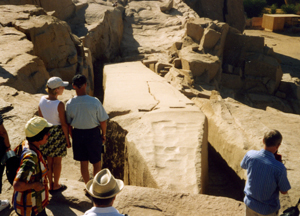|
The Trip Down the Nile
In November 2001 I visited Egypt. The first week
was a cruise down the Nile from Luxor to Aswan and back - the same trip that
Danny and Katy take in the book. On this page you can see some photos I took
of the various sights which I, and my characters, viewed en route.
Click here to see a map.
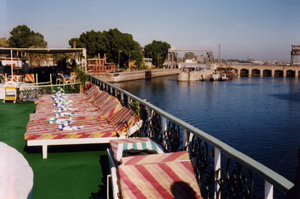 The
Boat The
Boat
I stayed on the Viking II, a cruise ship for
English travellers who were divided into two groups for touring. My guide
was Ahmed - the other's was called Osama, which caused a few jokes as the
cruise took place only two months after September 11th. Ahmed was a nice
bloke who gave us lots of background details during each site visit (though
a few of them were wrong...). Here you see the top deck on which I spent
many an hour sunbathing.
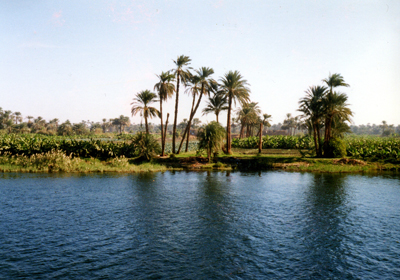
The River
The
famous river Nile was gorgeous to look at. Deep blue reflections of the sky,
but dark green if you looked straight down. Luxuriant green fields on each
bank, lazy palm trees everywhere.
And at night it was no less lovely.
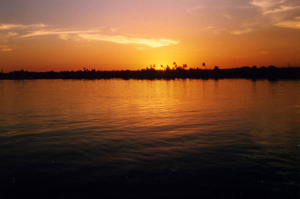 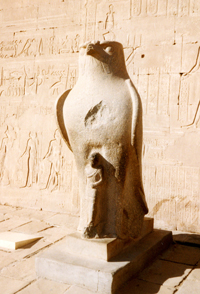
Edfu
Our first stop was the Temple of Horus at
Edfu. This was built very late on in Egyptian history, during the Ptolemaic
period when Greek kings ruled Egypt (exact details: Ptolemy III started it
in 237BC, and it was finished by Ptolemy XIII in 57 BC). Edfu had always
been sacred to Horus, however. It is the best preserved temple in Egypt with
a full hieroglyphic retelling of the myth of Horus and Seth. And of course
the statues of angry Horus (it's Seth he's angry at, for killing his father
Osiris).
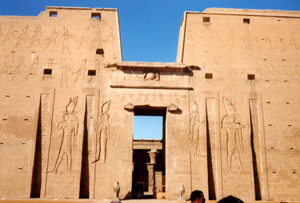 Those
niches in the pylon, by the way, were for the four flagpoles. The holes
above were for raising and changing the flags. Can you see the image of
Horus on the wall, with the double crown? Those
niches in the pylon, by the way, were for the four flagpoles. The holes
above were for raising and changing the flags. Can you see the image of
Horus on the wall, with the double crown?
One unpleasant side of Egypt is that at every
ancient site there are traders who descend like vultures on visitors. They
use the most aggressive methods to sell their wares. One salesman after
getting me to buy a scarf wouldn't give me the right change and wouldn't
take the scarf back. He only gave in when I threatened to go to a policeman.
So if you go to Egypt use these words and learn them well: 'la shokran!' (=
no thanks).
Kom Ombo
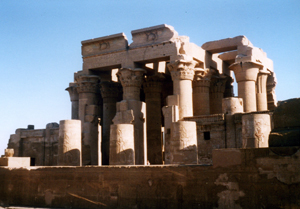 Kom
Ombo was next, a bit further down the Nile. Like Edfu this
was an ancient temple (according to Ahmed
it was built by Thutmose III), later rebuilt by the Ptolemies (Ptolemy VI to
be exact - and later completed by the Roman emperor Augustus in 30 BC). It
was dedicated unusually to two gods - Horus and Sobek (see Sobek right).
Each god had one half - left or right - of the temple. There were lots of
crocodiles in the Nile in this area, and people kept getting eaten. The
temple was built partly to honour Sobek so he would stop his creatures doing
such nasty things. Sacred crocodiles were kept in the grounds and mummified
when they died. Kom
Ombo was next, a bit further down the Nile. Like Edfu this
was an ancient temple (according to Ahmed
it was built by Thutmose III), later rebuilt by the Ptolemies (Ptolemy VI to
be exact - and later completed by the Roman emperor Augustus in 30 BC). It
was dedicated unusually to two gods - Horus and Sobek (see Sobek right).
Each god had one half - left or right - of the temple. There were lots of
crocodiles in the Nile in this area, and people kept getting eaten. The
temple was built partly to honour Sobek so he would stop his creatures doing
such nasty things. Sacred crocodiles were kept in the grounds and mummified
when they died.
On the walls of the temple there was a black
stain up to about chest height, which showed an ancient very high flood. I
used this idea later in the book...
Aswan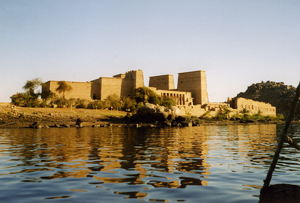
Finally we reached the city of Aswan. There
were so many cruise ships moored here that they had to line up side by side,
and I had to walk through five other ships to get to the shore. There's lots
to see in Aswan:
1. The high dam, built in 1960 to provide
electrical power, but which ended the summer floods which had brought
life-giving fertile mud to the ancient Egyptians for thousands of years. It
also caused the flooding of a large number of ancient temples and villages.
2. The Temple of Isis (see right), also known
as Philae, after the island it was originally built on. After the Aswan dam
was built, a lake (Nasser) was created to the south of it which would have
submerged the island, so they removed and reconstructed it on another
island. An amazing project.
3. The Island of Elephantine (which I didn't
visit) with various ancient remains.
4. Kitchener's Island, with its lovely
botanical gardens.
5. Aswan market - colourful indeed (see
right).
6. The Unfinished Obelisk. We visited a
quarry of pink granite used by the ancient Egyptians, with its famous
unfinished obelisk. There is some debate but most people think it was
commissioned by Hatshepsut. It would have been the largest in Egypt - 42m
high, but a crack appeared in it and it was abandoned. Obelisks were always
built in pairs, so presumably this was the first of such a pair as another
one has not been found.
|
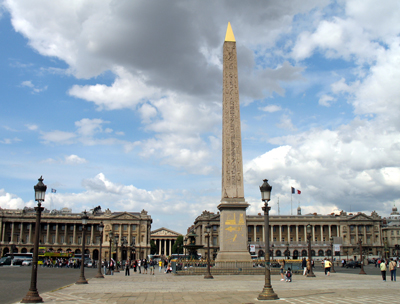
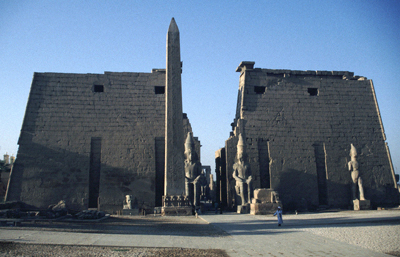

 The
Boat
The
Boat


 Those
niches in the pylon, by the way, were for the four flagpoles. The holes
above were for raising and changing the flags. Can you see the image of
Horus on the wall, with the double crown?
Those
niches in the pylon, by the way, were for the four flagpoles. The holes
above were for raising and changing the flags. Can you see the image of
Horus on the wall, with the double crown? 
 Kom
Ombo was next, a bit further down the Nile. Like Edfu this
was an ancient temple (according to Ahmed
it was built by Thutmose III), later rebuilt by the Ptolemies (Ptolemy VI to
be exact - and later completed by the Roman emperor Augustus in 30 BC). It
was dedicated unusually to two gods - Horus and Sobek (see Sobek right).
Each god had one half - left or right - of the temple. There were lots of
crocodiles in the Nile in this area, and people kept getting eaten. The
temple was built partly to honour Sobek so he would stop his creatures doing
such nasty things. Sacred crocodiles were kept in the grounds and mummified
when they died.
Kom
Ombo was next, a bit further down the Nile. Like Edfu this
was an ancient temple (according to Ahmed
it was built by Thutmose III), later rebuilt by the Ptolemies (Ptolemy VI to
be exact - and later completed by the Roman emperor Augustus in 30 BC). It
was dedicated unusually to two gods - Horus and Sobek (see Sobek right).
Each god had one half - left or right - of the temple. There were lots of
crocodiles in the Nile in this area, and people kept getting eaten. The
temple was built partly to honour Sobek so he would stop his creatures doing
such nasty things. Sacred crocodiles were kept in the grounds and mummified
when they died.

